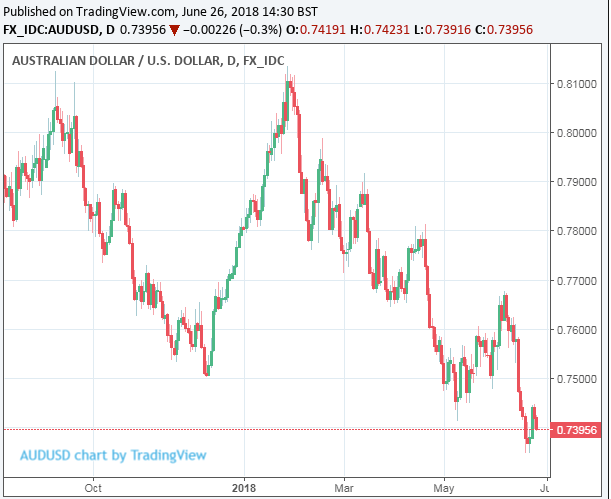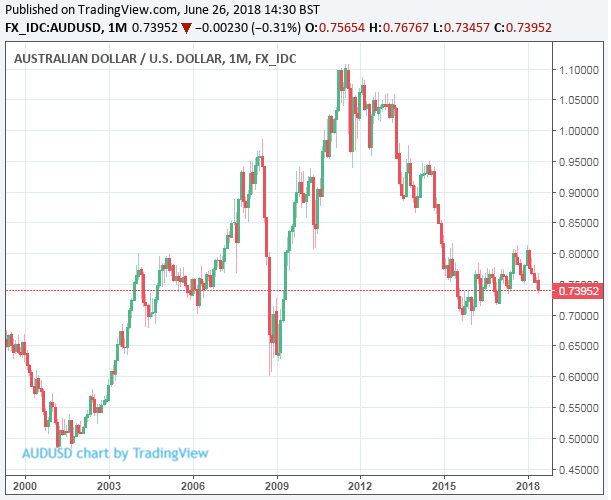Australian Dollar: Rabobank Cuts Forecasts as Morgan Stanley Bets on Return to Financial Crisis Lows
- Written by: James Skinner

© Goroden Kkoff, Adobe Stock
The Australian Dollar outlook has gone from bad to worse in 2018 and the Antipodean unit is now liable for further declines in the months ahead, according to forecasts from analysts at Rabobank, who have warned of losses around the same time as Morgan Stanley strategists bet on a return to financial crisis lows for the currency.
Bearish calls are mounting as the Aussie trades at a year-low against the Dollar after having fallen 5.2% in 2018. It was first hit by a deterioration in the Aussie inflation outlook that saw markets give up all hope of an interest rate rise in 2018, although increasingly the currency is now suffering due to its close links with China and sensitivity to global risk appetite.
"There is the risk that a trade war could raise difficult choices for Australia between its largest trade partner and its largest defence ally. Equally, however, there is a risk that Australia will have very little bargaining power, meaning it may have little control on how a US/China trade war impacts its domestic producers," says Jane Foley, an FX strategist at Rabobank.
Australia's largest trading partner is China and it is the world's second largest economy that has bore the brunt of President Donald Trump's attempt to reduce the US goods trade deficit. This means Australia's fortune is tied to that of the Chinese economy, which has become the target of US tariffs for export goods ranging from industrial metals to technology items.

Above: AUD/USD rate shown at daily intervals.
"There is risk that demand for Australia products could stall if growth in China slows as a result of the US’s attempt to improve its trade deficit. In the first instance this would impact Australia’s key exports such as iron ore, coal. This would eventually feed back into household incomes and consumer demand," Foley adds.
And with Australia's exports overwhelming comprised of commodity items like iron ore, coal and liquefied natural gas, the Aussie Dollar and economy is also vulnerable to the changing whims of global investor sentiment.
After all, commodity prices are most sensitive to changing expectations for global growth, but particularly growth in economies like China, which is the country that buys the lion's share of raw materials sold on international markets.
If a tit-for-tat tariff fight between the US and China leads investors to fear for the global economy, then the Aussie would be among the first casualties.
"The uncertainties connected with trade provide a good reason for the RBA to remain watchful going forward," Foley writes, in a recent briefing for clients. "The next RBA policy decision is scheduled for July 3. We would expect a greater discussion about potential risks associated with trade at this meeting."
The Reserve Bank Australia has held its interest rate at a record low of 1.5% for nearly two years, citing below-target inflation and weak wage growth that is hobbling that ability of debt laden households' to cope with higher borrowing costs.
This stance comes from the RBA even as the US Federal Reserve and other central banks draw a line under their post-crisis monetary policies by raising their interest rates back toward normal levels.
This has undermined the Australian Dollar in 2018 because the Antipodean currency has traditionally enjoyed support from interest rates that were typically higher than those offered elsewhere in the world.

Above: AUD/USD rate shown at monthly intervals.
"In view of our concerns about the impact of trade wars and in view of our expectations of steady RBA policy well into next year, we see further downside potential for AUD/USD towards 0.72 on a 12 mth view," Foley says, forecasting the Aussie will fall to its lowest level against its US rival since January 2017.
The AUD/USD rate was quoted 0.13% lower at 0.7401 Tuesday and has been as low as 0.7344 in recent days. Foley's forecast for a continued decline toward the 0.72 threshold comes hard on the heels of a recommendation from the FX team at Morgan Stanley that clients of the bank bet against the Australian Dollar during the weeks ahead.
"We like trading AUD/USD lower, but we wait for a tactical rebound to enter. AUD has the highest correlation to global equities within the G10, meaning it is particularly vulnerable to declining market risk sentiment. Risk assets look tenuous given rising trade protectionist rhetoric and declining global liquidity," says Gek Teng Khoo, an FX strategist at Morgan Stanley, in a recent briefing. "The key risk to the trade is that risk sentiment improves materially."
Khoo and Morgan Stanley team recommended on June 20 that clients wait for the AUD/USD rate to rise back to .7440 before entering "short" trades that target a move down to 0.68, which would mark the exchange rate's lowest level since March 2009. They have a stop-loss set at 0.7630.
Advertisement
Get up to 5% more foreign exchange by using a specialist provider to get closer to the real market rate and avoid the gaping spreads charged by your bank when providing currency. Learn more here




